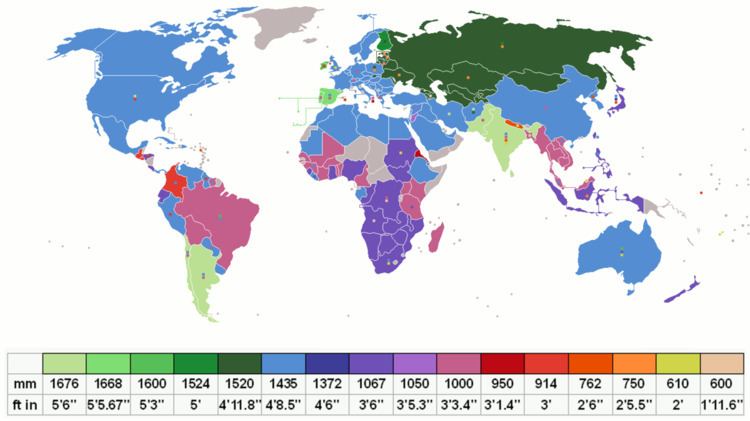Railways with track gauge of 5 ft 3 in (1,600 mm) are broad gauge railways, currently in use in Australia, Brazil and Ireland.
600 BCEThe
Diolkos (Δίολκος) across the
Isthmus of Corinth in Greece – a grooved paved trackway – was constructed with an average gauge of
5 ft 3 in (
1,600 mm).
1840The
Grand Duchy of Baden State Railway was constructed to
5 ft 3 in gauge, converted to
4 ft 8 1⁄2 in (
1,435 mm)
standard gauge in 1854–1855.
1843The
Board of Trade of the United Kingdom recommended the use of
5 ft 3 in in Ireland, after investigating a dispute caused by diverse gauges in Ireland.
1846The Regulating the Gauge of Railways Act 1846 made this gauge mandatory throughout all of Ireland.
1847The
Swiss Northern Railway was opened, converted to standard gauge in 1854.
1854The first Australian
5 ft 3 in line was opened, the
Melbourne and Hobson's Bay Railway Company.
1858The first Brazilian
5 ft 3 in railway was opened, the Companhia de Estrada de Ferro Dom Pedro II.
1863The Canterbury Provincial Railways in New Zealand was built in
5 ft 3 in until gauge conversion to
3 ft 6 in (
1,067 mm) in 1876
In Ireland this gauge is known as Irish gauge.In Australia this gauge is known as Victorian Broad Gauge.In Brazil this gauge is mainly known as Bitola larga (Broad gauge), but it is also less known as Bitola irlandesa (Irish gauge).The Pennsylvania trolley gauges of 5 ft 2 1⁄2 in (1,588 mm) and 5 ft 2 1⁄4 in (1,581 mm) are similar to Irish gauge. There is also 5 ft 2 in (1,575 mm) gauge, which is similar as well. See: Track gauge in Ireland.
One of the supposed advantages of the broader 1,600 mm (5 ft 3 in) Irish gauge, compared to 1,435 mm (4 ft 8 1⁄2 in) standard gauge, is that the greater space between the wheels allows for bigger cylinders. In practice, Ireland does not have any heavily-loaded or steeply-graded lines that would require especially powerful locomotives. The most powerful steam locomotives on systems of this gauge were:
Ireland – GSR Class 800 – Tractive effort: 155 kN (34,850 lbf)Victoria – Victorian Railways H class – 245 kN (55,080 lbf); 23.6 t (23.2 long tons; 26.0 short tons) axle load – 1 in 48 (2.1%) grade.By comparison a non-articulated standard gauge locomotive in the same country was:
NSW D57 class locomotive of 286 kN (64,300 lbf) – 1 in 33 (3.333 %) grades 
